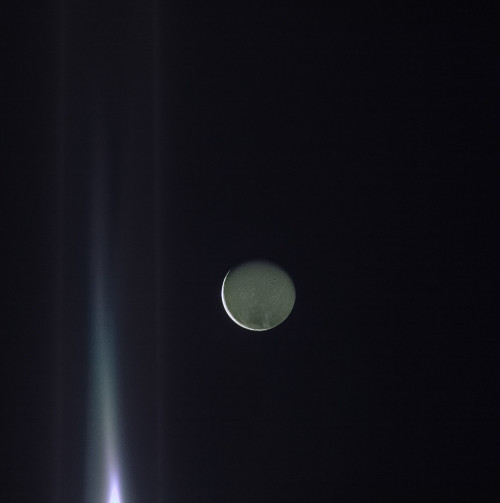🌌☄️🌃🍂🍁
🌌☄️🌃🍂🍁

2024 August 14
Meteors and Aurora over Germany Image Credit & Copyright: Chantal Anders
Explanation: This was an unusual night. For one thing, the night sky of August 11 and 12, earlier this week, occurred near the peak of the annual Perseid Meteor Shower. Therefore, meteors streaked across the dark night as small bits cast off from Comet Swift-Tuttle came crashing into the Earth’s atmosphere. Even more unusually, for central Germany at least, the night sky glowed purple. The red-blue hue was due to aurora caused by an explosion of particles from the Sun a few days before. This auroral storm was so intense that it was seen as far south as Texas and Italy, in Earth’s northern hemisphere. The featured image composite was built from 7 exposures taken over 26 minutes from Ense, Germany. The Perseids occur predictably every August, but auroras visible this far south are more unusual and less predictable.
∞ Source: apod.nasa.gov/apod/ap240814.html
More Posts from Monstrous-mind and Others
🔭🌃🌌🐈

Located over 50 million light years away, the large, distorted spiral NGC 1532 is seen locked in a gravitational struggle with dwarf galaxy NGC 1531 (right of center), a struggle the smaller galaxy will eventually lose.
Image Credit: Michel Meunier, Laurent Bernasconi, Janus Team
🍁🍂🎃🍂🍁

Autumn Alley, Germany …..by Michael Boehmlaend
🔭🪐🌌🌘☄️

2024 June 23
The Colors of Saturn from Cassini Image Credit: NASA, ESA, JPL, ISS, Cassini Imaging Team; Processing & License: Judy Schmidt
Explanation: What creates Saturn’s colors? The featured picture of Saturn only slightly exaggerates what a human would see if hovering close to the giant ringed world. The image was taken in 2005 by the robot Cassini spacecraft that orbited Saturn from 2004 to 2017. Here Saturn’s majestic rings appear directly only as a curved line, appearing brown, in part from its infrared glow. The rings best show their complex structure in the dark shadows they create across the upper part of the planet. The northern hemisphere of Saturn can appear partly blue for the same reason that Earth’s skies can appear blue – molecules in the cloudless portions of both planet’s atmospheres are better at scattering blue light than red. When looking deep into Saturn’s clouds, however, the natural gold hue of Saturn’s clouds becomes dominant. It is not known why southern Saturn does not show the same blue hue – one hypothesis holds that clouds are higher there. It is also not known why some of Saturn’s clouds are colored gold.
∞ Source: apod.nasa.gov/apod/ap240623.html
🍁🍂🎃🌄

Wistfully Country on Pinterest.

NASA’s TESS Mission Hopes to Find Exoplanets Beyond Our Solar System : The worlds orbiting other stars are called “exoplanets,” and they come in a wide variety of sizes, from gas giants larger than Jupiter to small, rocky planets about as big around as Earth or Mars. This rocky super-Earth is an illustration of the type of planets future telescopes, like NASA’s TESS, hope to find outside our solar system. (via NASA)

🎃 kitty and her pumpkin coven 🎃
10 Things: Calling All Pluto Lovers
June 22 marks the 40th anniversary of Charon’s discovery—the dwarf planet Pluto’s largest and first known moon. While the definition of a planet is the subject of vigorous scientific debate, this dwarf planet is a fascinating world to explore. Get to know Pluto’s beautiful, fascinating companion this week.
1. A Happy Accident

Astronomers James Christy and Robert Harrington weren’t even looking for satellites of Pluto when they discovered Charon in June 1978 at the U.S. Naval Observatory Flagstaff Station in Arizona – only about six miles from where Pluto was discovered at Lowell Observatory. Instead, they were trying to refine Pluto’s orbit around the Sun when sharp-eyed Christy noticed images of Pluto were strangely elongated; a blob seemed to move around Pluto.
The direction of elongation cycled back and forth over 6.39 days―the same as Pluto’s rotation period. Searching through their archives of Pluto images taken years before, Christy then found more cases where Pluto appeared elongated. Additional images confirmed he had discovered the first known moon of Pluto.
2. Forever and Always

Christy proposed the name Charon after the mythological ferryman who carried souls across the river Acheron, one of the five mythical rivers that surrounded Pluto’s underworld. But Christy also chose it for a more personal reason: The first four letters matched the name of his wife, Charlene. (Cue the collective sigh.)
3. Big Little Moon

Charon—the largest of Pluto’s five moons and approximately the size of Texas—is almost half the size of Pluto itself. The little moon is so big that Pluto and Charon are sometimes referred to as a double dwarf planet system. The distance between them is 12,200 miles (19,640 kilometers).
4. A Colorful and Violent History

Many scientists on the New Horizons mission expected Charon to be a monotonous, crater-battered world; instead, they found a landscape covered with mountains, canyons, landslides, surface-color variations and more. High-resolution images of the Pluto-facing hemisphere of Charon, taken by New Horizons as the spacecraft sped through the Pluto system on July 14 and transmitted to Earth on Sept. 21, reveal details of a belt of fractures and canyons just north of the moon’s equator.
5. Grander Canyon

This great canyon system stretches more than 1,000 miles (1,600 kilometers) across the entire face of Charon and likely around onto Charon’s far side. Four times as long as the Grand Canyon, and twice as deep in places, these faults and canyons indicate a titanic geological upheaval in Charon’s past.
6. Officially Official

In April 2018, the International Astronomical Union—the internationally recognized authority for naming celestial bodies and their surface features—approved a dozen names for Charon’s features proposed by our New Horizons mission team. Many of the names focus on the literature and mythology of exploration.
7. Flying Over Charon
This flyover video of Charon was created thanks to images from our New Horizons spacecraft. The “flight” starts with the informally named Mordor (dark) region near Charon’s north pole. Then the camera moves south to a vast chasm, descending to just 40 miles (60 kilometers) above the surface to fly through the canyon system.
8. Strikingly Different Worlds

This composite of enhanced color images of Pluto (lower right) and Charon (upper left), was taken by New Horizons as it passed through the Pluto system on July 14, 2015. This image highlights the striking differences between Pluto and Charon. The color and brightness of both Pluto and Charon have been processed identically to allow direct comparison of their surface properties, and to highlight the similarity between Charon’s polar red terrain and Pluto’s equatorial red terrain.
9. Quality Facetime

Charon neither rises nor sets, but hovers over the same spot on Pluto’s surface, and the same side of Charon always faces Pluto―a phenomenon called mutual tidal locking.
10. Shine On, Charon

Bathed in “Plutoshine,” this image from New Horizons shows the night side of Charon against a star field lit by faint, reflected light from Pluto itself on July 15, 2015.
Read the full version of this week’s ‘10 Things to Know’ article on the web HERE.
Make sure to follow us on Tumblr for your regular dose of space: http://nasa.tumblr.com.
🍂🍁🌄

🔭🌌


Dione (moon of Saturn) 2005 and 2015
Credit: NASA/JPL-Caltech/SSI/Kevin M. Gill

-
 starryfull13 reblogged this · 7 months ago
starryfull13 reblogged this · 7 months ago -
 justabunchofdragons reblogged this · 8 months ago
justabunchofdragons reblogged this · 8 months ago -
 groundpilot13 liked this · 8 months ago
groundpilot13 liked this · 8 months ago -
 2203312 liked this · 8 months ago
2203312 liked this · 8 months ago -
 astudyinimagination liked this · 8 months ago
astudyinimagination liked this · 8 months ago -
 steampunk483 reblogged this · 8 months ago
steampunk483 reblogged this · 8 months ago -
 algorizmi reblogged this · 8 months ago
algorizmi reblogged this · 8 months ago -
 12-acts-of-creation reblogged this · 8 months ago
12-acts-of-creation reblogged this · 8 months ago -
 ipswitch-north liked this · 8 months ago
ipswitch-north liked this · 8 months ago -
 ace-of-hail liked this · 8 months ago
ace-of-hail liked this · 8 months ago -
 kitsunalunaa reblogged this · 8 months ago
kitsunalunaa reblogged this · 8 months ago -
 gregorlenko liked this · 8 months ago
gregorlenko liked this · 8 months ago -
 lunahalimede liked this · 9 months ago
lunahalimede liked this · 9 months ago -
 hagymasbab liked this · 9 months ago
hagymasbab liked this · 9 months ago -
 leonorthoughts reblogged this · 9 months ago
leonorthoughts reblogged this · 9 months ago -
 leonorthoughts liked this · 9 months ago
leonorthoughts liked this · 9 months ago -
 dragonflysrevenge liked this · 9 months ago
dragonflysrevenge liked this · 9 months ago -
 kalyssto reblogged this · 9 months ago
kalyssto reblogged this · 9 months ago -
 kalyssto liked this · 9 months ago
kalyssto liked this · 9 months ago -
 annapolisrose liked this · 9 months ago
annapolisrose liked this · 9 months ago -
 cynicspirits liked this · 9 months ago
cynicspirits liked this · 9 months ago -
 mister-moonshine liked this · 9 months ago
mister-moonshine liked this · 9 months ago -
 boccher reblogged this · 9 months ago
boccher reblogged this · 9 months ago -
 boccher liked this · 9 months ago
boccher liked this · 9 months ago -
 findingagain reblogged this · 9 months ago
findingagain reblogged this · 9 months ago -
 kerovousphoto liked this · 9 months ago
kerovousphoto liked this · 9 months ago -
 bemybabymp3 reblogged this · 9 months ago
bemybabymp3 reblogged this · 9 months ago -
 fabien-euskadi reblogged this · 9 months ago
fabien-euskadi reblogged this · 9 months ago -
 fireball763 liked this · 9 months ago
fireball763 liked this · 9 months ago -
 cbrodellic reblogged this · 9 months ago
cbrodellic reblogged this · 9 months ago -
 cbrodellic liked this · 9 months ago
cbrodellic liked this · 9 months ago -
 mymischa liked this · 9 months ago
mymischa liked this · 9 months ago -
 seriih liked this · 9 months ago
seriih liked this · 9 months ago -
 fabien-euskadi liked this · 9 months ago
fabien-euskadi liked this · 9 months ago -
 wigmund reblogged this · 9 months ago
wigmund reblogged this · 9 months ago -
 wigmund liked this · 9 months ago
wigmund liked this · 9 months ago -
 al-the-grammar-geek liked this · 9 months ago
al-the-grammar-geek liked this · 9 months ago -
 corduroy-leggings liked this · 9 months ago
corduroy-leggings liked this · 9 months ago -
 steampunk483 liked this · 9 months ago
steampunk483 liked this · 9 months ago -
 melocosmos reblogged this · 9 months ago
melocosmos reblogged this · 9 months ago -
 melocosmos liked this · 9 months ago
melocosmos liked this · 9 months ago -
 freewingthefree reblogged this · 9 months ago
freewingthefree reblogged this · 9 months ago -
 wanderer001 reblogged this · 9 months ago
wanderer001 reblogged this · 9 months ago -
 wanderer001 liked this · 9 months ago
wanderer001 liked this · 9 months ago -
 dabb444 liked this · 9 months ago
dabb444 liked this · 9 months ago -
 natejay42 liked this · 9 months ago
natejay42 liked this · 9 months ago -
 freewingthefree liked this · 9 months ago
freewingthefree liked this · 9 months ago -
 hellfighter8 liked this · 9 months ago
hellfighter8 liked this · 9 months ago
My ambition is handicapped by laziness. -C. Bukowski Me gustan las personas desesperadas con mentes rotas y destinos rotos. Están llenos de sorpresas y explosiones. -C. Bukowski. I love cats. Born in the early 80's, raised in the 90's. I like Nature, Autumn, books, landscapes, cold days, cloudy Windy days, space, Science, Paleontology, Biology, Astronomy, History, Social Sciences, Drawing, spending the night watching at the stars, Rick & Morty. I'm a lazy ass.
222 posts